#baiji icons
Explore tagged Tumblr posts
Text
✎ : 𝐒𝐞𝐯𝐞𝐧 𝐒𝐡𝐮𝐬 𝐢𝐜𝐨𝐧𝐬







#honkai impact 3rd#hi3rd#hi3#honkai icons#the seven shus#demon's matching icons#thelema#songque#lantern#baiji#litost#serapeum#ajita#pink aesthetic#brown aesthetic#blue aesthetic#anime icons#game icons#halloween official art
21 notes
·
View notes
Text
xiong qi asking for baijie's name, and she's like "ruan baijie, but you can call me jiejie 🥺🥺🥺", and so he calls her jiejie without thinking and then like, "wait, nevermind", iconic
15 notes
·
View notes
Text
fucking hell i keep accidentally opening the most iconic pages first. Qiushi hears one of sisters say i'm cold and is like dammit it's all Baijie's influence on her i know what she means by this. nope won't work on me here is a blanket *i don't control the weather meme*
the first thing i read of my Kaleidoscope of Death copy being
LQS: What's with your obsession with noodles?
RBJ: I'm not obsessed. Just like sucking on your noodle...
fitting
11 notes
·
View notes
Text









#tokyo revengers#tokrev#tokyo revengers icons#tokyo revengers manga#anime icons#mangá icons#anime users#anime moodboard#anime bios#mikey icons#anime carrd#carrd resources#my carrd#messy bios#messy locs#anime messy#takemichi icons#baiji icons#draken icons#chifuyu icons#kazutora icons#hanma icons
687 notes
·
View notes
Photo




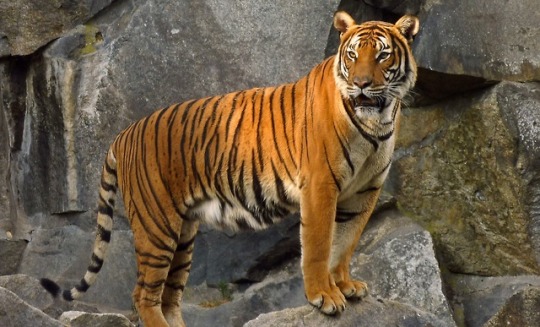


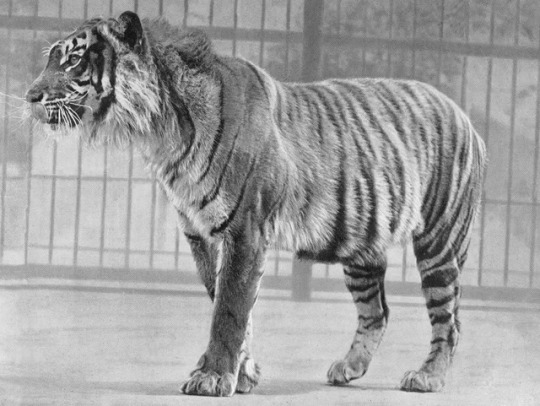

Endangered Felines, part 1
Tiger, Panthera tigris
Without a doubt one of the most iconic and recognizable animals on Earth, the tiger was voted the world’s favorite animal in 2004, with the domestic dog coming in second, and dolphins third.
I was planning on splitting tigers into one post per subspecies, but since there are sadly so many cat species that are endangered, this series will be long enough already, and it gives a better overview to have them all in one post.
And just as I was researching for this post, it turns out that in 2017, the tiger was reduced to a mere two subspecies - the mainland (P. t. tigris), and the Sunda Island (P. t. sondaica) populations - but this is disputed, as there are morphological and genetic differences between these populations. In this post, I will treat them all as their own subspecies.
While at first I was a bit skeptical about the switch to now only having two tiger subspecies when I think about it more, it's actually great for tiger conservation, because that means we don't have to be "subspecies purists" anymore. This means we can repopulate areas with another population easier, without claims of "it's an invasive/foreign animal".
While I will try to keep each topic brief, this will still be a lengthy and exhaustive post, as you can’t simply brush over things in the most beloved and famous endangered animal on Earth.

This is the historic range of all tigers. From the far northeast of Russia to the east of the Black Sea, by Georgia, Armenia and Azerbaijan, all the way to the far southern islands of Java and Bali.
Today, they have been extirpated from most of their range, with three of the nine former subspecies extinct. By 2017, there were just under 4000 tigers in the wild combined, and that is after a recent rise in numbers, for the first time in over a century. A couple of hundred years ago, there were at least 40 000 tigers in India alone.
They are estimated globally to have numbered around 100 000 in the year 1900, meaning 97% of tigers were lost in a century.
Occasionally hunted throughout history, either because of fear, sport among the wealthy or for their parts, tiger hunts took on a new dimension when Europeans colonized India and other parts of South Asia, with "gentlemen sports hunters" proudly subduing nature. And later in the 20th and 21st centuries, mainly poaching for body parts used in "traditional medicine".

An Indian tiger hunt carried out by Lord Reding, Viceroy of India, likely in the mid-1920s.
Direct hunting is not the only threat against tigers, as the human population in Southeast Asia has exploded over the past century, and today, there is nowhere left for wildlife to go.
The tiger has been listed as endangered under the IUCN, consistently since its first assessment in 1986.

Bengal tiger, Panthera tigris tigris
The Bengal is without a doubt the most well-known of all tiger subspecies, not the least due to our strong association of tigers with Indian culture. They are also the most numerous tiger population today.
They are 90-110 cm tall at the shoulders and weigh up to 325 kg, with males averaging 235 kg, and females ranging from 116-164 kg.
Given a separate assessment by the IUCN in 2008, the Bengal tiger is considered endangered. Today, they number around 2300 animals in the wild, 1700 of which are in India, 440 in Bangladesh, 200 in Nepal, and 75-100 in Bhutan.
The population is severely fragmented, and no subpopulation contains more than 250 animals. Despite cautiously optimistic news a couple of years ago, they are still considered "decreasing".
If 40 000 was the original number of tigers in India, today, there are only 4% left, and it is still the biggest stronghold of wild tigers anywhere.

Amur tiger, P. t. altaica
More famously known as Siberian tiger, this name is inaccurate as they don't live anywhere near Siberia, which is a large chunk of eastern Russia, having no eastern coastline. While the tiger lives in the very far southeast, near Korea. They are also known as the Manchurian, Ussurian and Korean tiger.
As can be seen on the map above however, they did have a far larger range before widespread hunting nearly wiped them out.
The largest cat on Earth today (after the extinction of the Caspian tiger), they are the second most numerous tiger population, at around 500 animals in the wild (in 2005, they were estimated at 360). They were saved on the brink of extinction, as only a couple of dozen animals remained when they were finally protected.
Despite this vast increase however, the effective population size is only equivalent to around 30 animals, which is close to the total world population when they were saved from extinction. This is due to inbreeding from a smaller and smaller population that then had only a handful of already related animals to rebound from.
It was in the early 20th century that the Amur tiger was nearly wiped out, due to the massive societal change that was going on in Russia at the time. Armies on both sides of the civil war based in Vladivostok made it their mission to kill as many tigers as they could.
Tigers were extirpated from the Korean peninsula by the Japanese in the same period, when Japan occupied Korea. Today, South Korea is working on once again creating a home for the Amur tiger in their lands.
The Soviet Union finally banned tiger hunting in 1947, after which anti-poaching control was very strict. Cubs kept being live-caught well into the 1960s however.
In the middle of the 1900s, deer populations fell in the Amur tiger's range, leaving them no choice but to find other prey. Bizarrely, more than 30 cases of tigers attacking bears were recorded, and bear hair was found in tiger droppings.
After the fall of the Soviet Union in 1991 and the subsequent economic and societal collapse, people were free to poach tigers again, with some doing it to sell to the Chinese market. Today however, the population is stable, but vulnerable.
In 1965, it was given the listing of "status inadequately known", and this was not changed until 1996, when they were assessed as "critically endangered". This laster until 2008, when they were moved to endangered.
At present, there are about as many Amur tigers in human care as there are in the wild, totalling about 1000 Amur tigers on the planet. The zoological population has a higher genetic diversity than wild tigers, as the foundation stock was largely caught when tigers were more numerous in the wild.
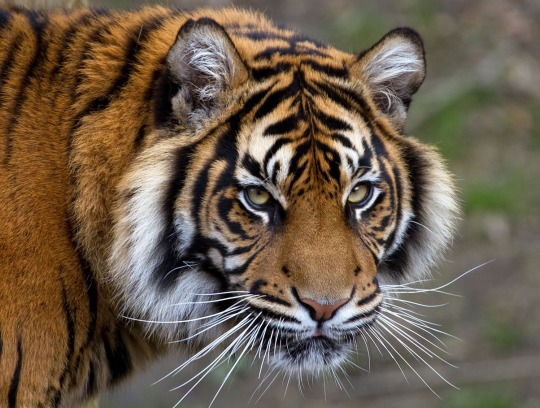
Sumatran tiger, P. t. sumatrae
The Sumatran is the one tiger that I personally can recognize easily, due to their striking and bold facial pattern. They are among the smallest tigers alive today, with males reaching only 140 kg - this is a size similar to jaguars. They are also the only Indonesian or Sunda island tiger still in existence.
The Sumatran tiger has been consistently listed as critically endangered since their first assessment in 1996.
They number approximately 500-600 animals, not including ones in zoos and other collections.
Their threats are mainly a shrinking habitat due to palm oil and Acacia plantations leading to a depletion of prey, as well as poaching for their body parts.
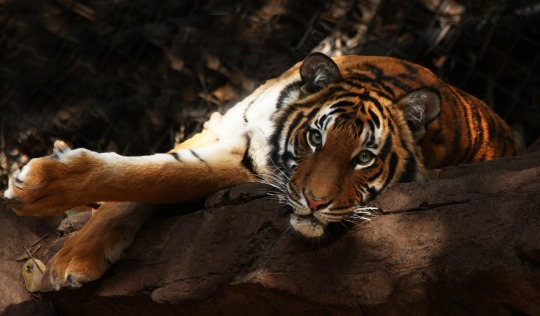
Malayan tiger, P. t. jacksoni
Although recent research has discovered that there is no real difference between this and the Indochinese tiger, it was considered its own subspecies since a DNA analysis in 2004, until the recent merge where all mainland tigers are considered P. t. tigris.
Subspecies or subpopulation, the Malayan tiger was listed as “endangered” in 2008, and in 2014, it was reassessed under its current listing as critically endangered.
This was because they had declined by 25% in only one generation (7 years).
In the 1950s, there were about 3000 Malayan tigers. In the 1990s, there were 500, and in 2013, they were estimated at 250-340 animals. This gives an estimate of only around 100 breeding adults in the wild.
The total number in human care is difficult to get to, but apparently in 2011, there were 54 Malayan tigers in American zoos alone, spread across 25 facilities.
The Malayan tiger's habitat has shrunk from nearly 100 000 square kilometers before 1970s, to less than 45 000 square kilometers in 2014. Aside from this threat, is of course poaching for body parts for a Chinese market. Between the years 2000-2013, body parts equating to 1425 tigers had been seized, 94 of these being Malayan tigers.
The Global Tiger Recovery Program, made up of 13 countries where tigers live, set a goal in 2010 to double their tiger populations by 2022. Malaysia had made a similar promise before this agreement, in 2009, with their National Tiger Conservation Action Plan setting to doubling Malaysia's tiger population by 2020.
With the new population estimate of 250-340 adult Tigers and diminishing prey base and natural forests, it is biologically impossible to reach the NTCAP target by 2020.
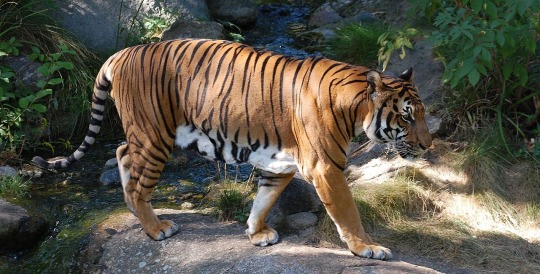
Indochinese tiger, P. t. corbetti
The Indochinese tiger lives in Southeast Asia, and is viewed as the ancestor of all tigers, the other subspecies diverging around 72 000-108 000 years ago.
They are functionally extinct in Vietnam, Cambodia and possibly China, and number around 300-400 animals in total, the largest population being in Thailand.
They have been listed as endangered since 2008.
They are the least represented in zoos out of all tiger subspecies, and no coordinated breeding program exists. Approximately 14 zoo tigers have been discovered to be Indochinese after DNA analysis of 105 animals in 14 countries.

South China tiger, P. t. amoyensis
This is the most threatened tiger subspecies as they are believed to be extinct in the wild, since the last time one was live-caught in the 1970s.
Only 20 years earlier, they numbered more than 4000 animals, but then came Mao Zedong's "Great Leap Forward", when all wildlife stood in the way of "progress" (remember the Baiji).
Large-scale government anti-pest campaigns took off, and tigers were massacred, mercilessly. This was made worse by deforestation, heavy settling of the countryside from the cities (as part of the GLF) and over-hunting of their prey.
By 1973, they were partially protected, and by 1977, hunting was completely prohibited.
By the early 1980s, they were estimated at 150-200 animals, though not one tiger has been seen since the early 70s.
They are considered critically endangered, possibly extinct in the wild, but there is hope there still are a handful of tigers holding on in the wilds of China. For example, in 2007, a bear and a cow were killed by what was most likely a tiger.
In 2005, the entire zoological population numbered 57 animals descended from only six tigers. Despite being inbred and suffering poor breeding success as a result, DNA tests showed many aren’t pure South China tigers anyway. Another estimate (made difficult by crossbreeding) in 2007 put the global zoological population at 72 animals.

Bali tiger, P. t. balica
The Bali tiger, formerly inhabiting only the island of Bali since 12 000 - 13 000 years back, was the smallest of all tigers, with males only reaching up to 100 kg and females 80 kg, putting this tiger around the same size as a jaguar or cougar.
They were only listed as extinct by the IUCN as late as 2008, but the last one probably died just after the second world war, with the last known tigers recorded in the 1930s.
The Bali tiger was killed off through a lethal cocktail of environmental destruction (palm plantations and rice fields) and sports hunting by the Dutch colonizers. The West Bali National Park was established in 1941, but it came too late to save the tiger.
This animal was never filmed alive nor held in zoos (though it seems the Ringling Bros Circus had one), and it is very difficult to even find photos of live animals.

Javan tiger, P. t. sondaica
The Javan tiger was small, but just larger than the Bali, and similar in size to the still living Sumatran. They were notable in appearance by often having very sparse stripes around the front legs and shoulders.
This population was pronounced extinct by the IUCN in 2003, but the last confirmed sighting was recorded as far back as 1976. Several accounts of alleged sightings exist however, even within the last ten years, including a person supposedly being killed by a tiger in 2008.
In 2017, a blurry image surfaced of what was supposedly a Javan tiger. It was however most likely a Javan leopard, also a critically endangered cat.
We can always hope at least some of these alleged sightings were of tigers, but there is always the possibility that the animals witnessed were actually leopards.
At the turn of the last century, 28 million people lived on Java, while today, it is a jaw-dropping 145 million (resulting in a mind-blowing population density of 1.121 people per square kilometer - in comparison, the state of New York has a population denity of 416 people per square kilometer).
By the middle of the 1800s, people considered tigers a plague, and by the turn of the century, 150% more land had to be cleared for agriculture in only 15 years. By 1975, only 8% of the island's forests remained.
These tigers were poisoned, hunted, their main prey nearly died out, and the forests were cleared for lumber and agriculture.
To make things even worse, World War 2 happened, so the few that were kept in zoos were lost. After the war, it was easier to obtain Sumatran tigers, so none were taken from Java.
A funny thing to note is how the Javan people’s fear of the tiger led them to always referring to it as “Mr. Tiger”. They thought that if they spoke of it in a casual way, the tiger might hear them and take revenge.
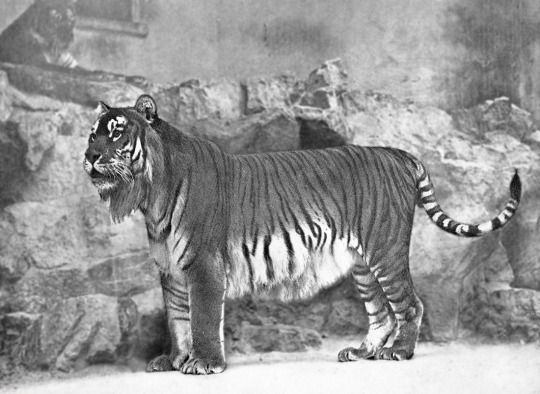
Caspian tiger, P. t. virgata
Like the Javan tiger, the Caspian was pronounced extinct by the IUCN in 2003, but the last record was in the early 1970s, and it died out some time during this decade.
It was possibly the largest cat in the world during recorded human history, after the ice age extinction of the cave lion.
It lived across parts of Georgia, Armenia and Azerbaijan, eastern Turkey, northern Iran, parts of Uzbekistan, Afghanistan, Turkmenistan, Kazakhstan, Kyrgyzstan, Tajikistan, even well into western China.
The last tiger in Georgia was shot in 1922, they were last recorded in Kazakhstan in 1948, one of the last in Iran was shot in 1953, the last in Turkmenistan was killed in 1954.
Tigers were killed both for sport and as pest control, including by the Soviet army. Up until World War 1, about a hundred tigers were killed in a forest area of the Afghanistan-Tajikistan border - every year. To make matters worse, their natural prey (pigs) declined heavily in the early 1900s due to overhunting and disease, and agriculture destroyed much of the tiger's natural habitat.
While this unique population is gone forever, there are plans to perhaps one day restock the area with Amur tigers, the closest living analogue to the Caspian tiger.
In a day when habitats are shrinking, other habitats may open up, and this could give the Amur tiger a greater hope to continue into the future.
The “there are more tigers in people’s backyards / basements than in the wild”-myth
More of a misrepresentation than a myth, it is true that there are more tigers in human care across the globe than there are in the wild. This is nothing strange for such an endangered animal.
The Scimitar-horned oryx, for example, was up until a couple of years ago extinct in the wild. There are now a few dozen roaming completely wild, while there are up to 11 000 of the antelopes in Texas alone.
The Eastern Bongo numbers around 400 animals in American collections alone, four times the population remaining in the wild!
The Przewalski's horse numbers around 2000 animals, and although many live in free-ranging reserves, only around 400 are considered truly wild and living in their native habitat, after reintroduction programs.
The Père David’s deer was extinct in the wild until some animals escaped and formed a population now some 700 strong, but it's still far outnumbered by the zoological population.
The blue-throated macaw numbers only around 300 animals in the wild, and the World Parrot Trust previously said there were "up to a thousand" in cages.
The Spix’s macaw numbers around 130 birds in human care, and was considered extinct in the wild since the last known bird disappeared in 2000, until one was discovered in 2016. If there are more in the wild, it is only a handful of scattered individuals.
The Hawaiian crow is extinct in the wild since 2002, with just over 100 birds in human care.
The Socorro dove has been extinct in the wild since 1972, with 150 birds alive today, all in cages.
The Guam rail is extinct in the wild since 1987, with some 160 birds alive in zoological facilities.
The orange-bellied parrot numbers around 340 in human care, with less than 20 in the wild.
It is however not true that there are more tigers in America than in the wild, let alone "in people's basements".
That claim is completely absurd, and while sometimes tigers are abused and neglected as with all animal species, that is extremely rare and would be far more common in their native Asia than in America.
According to the Feline Conservation Federation, the United States held just under 2900 tigers in 2011. In contrast, a decade ago in China, there were over 4000 tigers in human care in that country alone. The IUCN states (unknown date) that there are some 6000 tigers in China, mainly farmed for body parts.
We can debate the ethics of these various tiger facilities, but a large number also live in zoos and conservation centers. There is no such thing as several thousand "pet tigers" living in people's living rooms, backyards, or basements.

Privately owned tigers in America, courtesy of the Feline Conservation Federation.
But what the popular media likes to do, other than misrepresent the numbers (and say there are "10 000 pet tigers in American backyards" or some such nonsense), they also like to say that it's this vast number in human care ("captivity") that is the problem!
When people hear for example that there are 3000 tigers in the wild and 5000 or something in America, they seem to think America "stole" those tigers from the wild, and they must be put back! While in reality, tigers in the west have spent decades and generations on the continent, in zoos, circuses, and private collections.
And if you could take America's 2900 tigers and release them all, say hypothetically that it was allowed (many are not "pure") and that they could all survive in the wild. The threats on tigers in the wild, from poaching and habitat destruction, is still nowhere near gone.
So then we could have 5900 tigers for a while, and then a decade or two later, we'd be right back at 3000 again, with NOT ONE tiger alive in American breeding programs. Now who would that help?
That there are more tigers in human care than in the wild is a tragedy of the wild, not of "captivity".
In conclusion
Tigers are the most beloved endangered animal on the planet, and given both their popularity as well as their comparatively vast numbers in human care, the species stands a good chance at surviving indefinitely.
Whether that will only be in zoos, farms and other collections for the foreseeable future, or whether our children and grandchildren will have a chance to see tigers roaming freely in their natural habitats, free from persecution, is another question.
http://www.iucnredlist.org/details/15955/0
https://wildfact.com/forum/topic-on-the-edge-of-extinction-a-the-tiger-panthera-tigris?page=17
https://www.theguardian.com/uk/2004/dec/06/davidward
http://www.prweb.com/releases/2011/9/prweb8805806.htm
http://www.prweb.com/releases/2011/9/prweb8840075.htm
https://blog.nationalgeographic.org/2015/02/21/is-extinct-forever-central-asias-caspian-tiger-traverses-the-comeback-trail/
https://www.inverse.com/article/26481-caspian-tigers-extinct-central-asia-amur-kazakstan
https://asiancorrespondent.com/2018/04/south-korea-to-open-asias-largest-tiger-forest/
#Endangered Felines#tiger#Bengal tiger#Amur tiger#Siberian tiger#Sumatran tiger#Malayan tiger#Indochinese tiger#South China tiger#Bali tiger#Javan tiger#Caspian tiger#extinct animals#poaching#deforestation#Big Cat Rescue#BCR#pet tigers#pet tiger#exotic pets#Feline Conservation Federation
32 notes
·
View notes
Text
20 local books to read over your winter break in Tucson
Just because you can't make immediate travel plans right now doesn't mean you can't explore the world as an armchair traveler.
For the last three years, #ThisIsTucson has compiled a list of books with an Arizona connection as part of our Summer Reading Challenge for Grown-Ups. Many of these books are written by local or Tucson authors or are set in Tucson or Arizona. Some explore topics relevant to our region.
This list would be crazy long if we included all 72 titles from the past three years, so we selected a handful that span a variety of topics and genres. However, if you want to see the complete lists for 2020, 2019 and 2018, visit thisistucson.com/readingchallenge.
In the meantime, please enjoy exploring locations including the Highlands of Scotland, the Gulf of Mexico, national parks, our very own Sonoran Desert and so many more.
Goodreads ratings taken on Dec. 11, 2020.
Taste of Tucson: Sonoran-Style Recipes Inspired by the Rich Culture of Southern Arizona
Taste of Tucson: Sonoran-Style Recipes Inspired by the Rich
Culture of Southern Arizona by Jackie Alpers
Author: Jackie Alpers
Goodreads rating: 4.56 stars; 18 ratings
Arizona connection: Tucson author; Tucson food
Summary (from the library catalog): Cookbook. "A cookbook dedicated to the foods inspired by the region’s beauty and diversity, 'Taste of Tucson' discovers through recipes and photos the unique mix of cultures that create Southern Arizona’s incredible cuisine. Award-winning photographer and cookbook author Jackie Alpers shares her own inspired food creations in this book as well as her favorite restaurants’ dishes, while incorporating the history of the Sonora region, the mysticism and lore, and how it has contributed to the food of the people who live there. Building from tried-and-true basics and tutorials on tacos, enchiladas, carne asada, and huevos rancheros, she divulges secrets to making Sonora’s most unique savories and sweets, including Chicken Mole Amarillo, Adobo Pulled Pork, Red Pozole, Dark Chocolate and Coffee Figgy Pudding Cakes, and more. For cooks of all levels, from anywhere in the world who love to dine on this Southwestern region’s foods, this cookbook welcomes you to bring Sonora’s best and most iconic tastes into your own kitchen."
The Water Knife
The novel imagines a dystopian Phoenix sometime in the near future when the water has dried up.
Author: Paolo Bacigalupi
Goodreads rating: 3.84 stars; 21,355 ratings
Arizona connection: Set in Arizona/Phoenix
Summary (from the library catalog): Fiction. "The American Southwest has been decimated by drought. Nevada and Arizona skirmish over dwindling shares of the Colorado River, while California watches, deciding if it should just take the whole river all for itself. Into the fray steps Las Vegas water knife Angel Velasquez. Detective, assassin, and spy, Angel 'cuts' water for the Southern Nevada Water Authority, ensuring that lush, luxurious arcology developments can bloom in the desert and that anyone who challenges her is left in the gutted-suburban dust. When water is more valuable than gold, alliances shift like sand, and the only truth in the desert is that someone will have to bleed if anyone hopes to drink."
Vaquita: Science, Politics, and Crime in the Sea of Cortez
Author: Brooke Bessesen
Goodreads rating: 4.37 stars; 81 ratings
Tucson connection: Arizona author
Summary (from the library catalog): Nonfiction. “In 2006, the last of China's Yangtze river dolphins—baiji—succumbed to extinction, and la vaquita marina, a diminutive porpoise endemic to the Upper Gulf of California, quietly and without fanfare inherited the title of world's most endangered marine mammal. Unlike many other critically endangered species, the vaquita is not hunted. Nor is its habitat disappearing or degraded. The species is even protected by law. Why then have its numbers plummeted to near extinction when few humans have seen it live in the wild? The answer lies in a shadowy mix of international cartels, fishermen entrapped by politics and culture, and an unlikely fish called the totoaba. In this haunting story, Brooke Bessesen sets out to Mexico's Upper Gulf region to untangle the intricacies of the biology, acoustical science, and international intrigues behind the vaquita's decline. She interviews townspeople, fishermen, politicians, scientists, and activists, teasing apart a complex story filled with villains and heroes, a story whose outcome is unclear. When diplomatic and political efforts to save the little porpoise fail, Bessesen follows a team of veterinary experts in a binational effort to capture the last remaining vaquitas and breed them in captivity—the best hope for their survival.”
Insignificant Events in the Life of a Cactus
Author: Dusti Bowling
Goodreads rating: 4.33 stars; 13,957 ratings
Tucson connection: Set in Arizona; Arizona author
Summary (from the library catalog): Fiction. "New friends and a mystery help Aven, 13, adjust to middle school and life at a dying western theme park in a new state, where her being born arm-less presents many challenges."
The Lost Letter
Author: Jillian Cantor
Goodreads rating: 4.22 stars; 9,679 ratings
Tucson connection: Tucson author
Summary (from the library catalog): Fiction. "Austria, 1938. Kristoff is a young apprentice to a master Jewish stamp engraver. When his teacher disappears during Kristallnacht, Kristoff is forced to engrave stamps for the Germans, and simultaneously works alongside Elena, his beloved teacher's fiery daughter, and with the Austrian resistance to send underground messages and forge papers. As he falls for Elena amidst the brutal chaos of war, Kristoff must find a way to save her, and himself. Los Angeles, 1989. Katie Nelson is going through a divorce and while cleaning out her house and life in the aftermath, she comes across the stamp collection of her father, who recently went into a nursing home. When an appraiser, Benjamin, discovers an unusual World War II-era Austrian stamp placed on an old love letter as he goes through her dad's collection, Katie and Benjamin are sent on a journey together that will uncover a story of passion and tragedy spanning decades and continents, behind the just fallen Berlin Wall."
source - https://thisistucson.com/tucsonlife/20-local-books-to-read-over-your-winter-break-in-tucson/article_c2973db8-3b3c-11eb-91f2-8f4c859a07a3.html

0 notes
Text
When Does it Make Sense to Undam a River?
[By Jon Honea]
Across the United States, dams generate hydroelectric power, store water for drinking and irrigation, control flooding and create recreational opportunities such as slack-water boating and waterskiing. But dams can also threaten public safety, especially if they are old or poorly maintained. On May 21, 2020, residents of Midland, Michigan were hastily evacuated when two aging hydropower dams on the Tittabawassee River failed, flooding the town.
I’m an ecosystem scientist and have studied the ecology of salmon streams in the Pacific Northwest, where dams and historical over-harvest have drastically reduced wild populations of these iconic fish. Now I’m monitoring how river herring are responding to the removal of two derelict dams on the Shawsheen River in Andover, Massachusetts.
There’s growing support across the U.S. for removing old and degraded dams, for both ecological and safety reasons. Every case is unique and requires detailed analysis to assess whether a dam’s costs outweigh its benefits. But when that case can be made, dam removals can produce exciting results.

Between 1850 and 2016, 63 dam failures with fatalities occurred across the U.S., killing an estimated 3,432 to 3,736 people. National Performance of Dams Program, Stanford University, CC BY-ND
Pros and cons of dams
It’s relatively easy to quantify the benefits that dams provide. They can be measured in kilowatt-hours of electricity generation, or acre-feet of water delivered to farms, or the value of property that the dams shield from floods.
Some dam costs also are obvious, such as construction, operation and maintenance. They also include the value of flooded land behind the dam and payments to relocate people from those areas. Sometimes dam owners are required to build and operate fish hatcheries to compensate when local species will lose habitat.
Other costs aren’t borne by dam owners or operators, and some have not historically been recognized. As a result, many were not factored into past decisions to dam free-flowing rivers.
Research shows that dams impede transport of sediment to the oceans, which worsens coastal erosion. They also release methane, a potent greenhouse gas, as drowned vegetation beneath dam reservoirs decomposes.
One of dams’ greatest costs has been massive reductions in numbers and diversity of migratory fish that move up and down rivers, or between rivers and the ocean. Dams have driven some populations to extinction, such as the iconic Baiji, or Yangtze River dolphin, and the once economically important Atlantic salmon on most of the U.S. east coast.
Old dams under stress
As dams age, maintenance costs rise. The average age of U.S. dams is 56 years, and seven in 10 will be over 50 by 2025. The American Society of Civil Engineers classifies 14% of the nation’s 15,500 high hazard potential dams – those whose failure would cause loss of human life and significant property destruction – as deficient in their maintenance status, requiring a total investment of US$45 billion to repair.
Like the failed Michigan dams, which were built in 1924, older dams may pose growing risks. Downstream communities can grow beyond thresholds that determined the dams’ original safety standards. And climate change is increasing the size and frequency of floods in many parts of the U.S.
These factors converged in 2017, when intense rainfall stressed the Oroville Dam in Northern California, the nation’s tallest dam. Although the main dam held, two of its emergency spillways – structures designed to release excess water – failed, triggering evacuations of nearly 200,000 people.
youtube
Benefits from free-flowing rivers
As dam owners and regulators increasingly recognize the downsides of dams and deferred maintenance costs mount, some communities have opted to dismantle dams with greater costs than benefits.
The first such project in the U.S. was the Edwards Dam on the Kennebec River in Augusta, Maine. In the mid-1990s when the dam was up for relicensing, opponents provided evidence that building a fish ladder – a step required by law to help migratory fish get past the dam – exceeded the value of the electricity that the dam produced. Federal regulators denied the license and ordered the dam removed.
Since then, the river’s river herring population has grown from less than 100,000 fish to more than 5,000,000, and the fish have drawn ospreys and bald eagles to the river. This project’s success catalyzed support for removing more than 1,000 other dams.
I’ve been studying one such project – removal of the derelict Balmoral and Marland Place dams on the Shawsheen River in Andover, Massachusetts. The owner of the Marland Place dam, originally built in the 18th century to power a mill, faced a $200,000 bill to restore it to safe condition. The Balmoral, an ornamental dam built in the 1920s, had changed hands so many times that the latest owner – a company in another state – wasn’t even aware that it owned a century-old dam in Massachusetts.
The project was a broad team effort. State environmental officials wanted to help restore the river’s health. Federal regulators supported removing the dams to open up historical habitat to migratory fish such as river herring, American shad and American eels. And Andover leaders wanted to improve recreation on the river.
Dam removals require extensive permitting and a lot of negotiation. For the Shawsheen project, experts from the nonprofit Center for Ecosystem Restoration in Rhode Island guided the many organizations involved through the process.
My role was organizing a volunteer effort to monitor the response of river herring that migrate from the ocean to spawn in freshwater systems. The fish didn’t disappoint. Although the first spawning season was less than three months after the dams were removed, data collected by local volunteer monitors – who number over 300 – indicated that the newly opened habitat had hosted approximately 1,500 river herring spawners for the first time in more than 100 years. Since then, numbers have fluctuated, following the pattern on the Merrimack River, into which the Shawsheen flows.
Like salmon, river herring mostly spawn where they hatched. During the previous three years of monitoring, spawners in the Shawsheen were all strays from elsewhere in the system. But this year we expected to see a large number of newly matured adults from our first year of monitoring.
Still growing
In April 2020, California’s State Water Resources Control Board approved two key permits for removing four large aging hydropower dams on the Klamath River in California and southern Oregon. This would be the largest dam removal in the U.S.
The board acted based on evidence that dam removal would improve drinking water quality by reducing algal blooms, and would restore habitat for endangered salmon and other organisms that rely on free-flowing rivers. The project still needs approval from the Federal Energy Regulatory Commission. Assuming it goes forward, I expect that a restored Klamath River will further fuel the movement to remove dams whose costs now clearly outweigh their benefits.
Jon Honea is an Assistant Professor of Science at Emerson College and a Conservation Commissioner for the Town of Andover, Massachusetts.
This article appears courtesy of The Conversation and may be found in its original form here.
from Storage Containers https://maritime-executive.com/article/when-does-it-make-sense-to-undam-a-river via http://www.rssmix.com/
0 notes
Text
Five wildlife films to watch during lockdown | Wild Animals
With human populations around the world being forced to take a back seat, emboldened animals are gliding through clear waterways, stepping out onto peaceful city streets and reclaiming deserted national parks.
Animal sightings are drawing wonder on social media. A jellyfish floating along the canals of Venice, a civet cat sauntering along a zebra crossing in Kerala, a puma lying asleep in a tree in a back yard in Boulder, Colorado, and others scouting the streets of Santiago. In Istanbul, dolphins are frolicking in the Bosphorus. In Thailand, on beaches devoid of tourists, more endangered leatherback turtle nests have been counted than at any time in the past two decades.
This only goes to show how damaging the human presence is. It is also, however, a welcome sign of nature’s ability to recover.
But, will it ever get a proper chance to bounce back? Even now, in what could be a respite, it is being hit when it is down.
The threat to wildlife continues apace. Places left unpatrolled and unprotected are particularly vulnerable. From the Amazon, to the African plains and the Himalayas, there is concern about encroachment not only from profiteers but also from people who are desperate to find food and fuel as the economic shock of the pandemic hits.
Restoration projects have come to a halt. Scientific expeditions have been cancelled. A major UN conference on biological diversity planned for later in the year has been postponed.
While animals run wild in parts of the planet usually occupied by humans and a pageant of beautiful creatures parades across screens, one million species are still facing extinction, many within decades. The 60 percent of animals we have wiped out since 1970 can never be brought back from the dead.
Several critical issues will be demanding our attention once the pandemic has abated. Conservation must be one of them. Healthy ecosystems are fundamental for a healthy planet and healthy people. We ransack, trade and consume animals as we do all the planet’s resources. And the results, as the COVID-19 pandemic shows only too clearly, can be fatal.
In the following five earthrise films we meet conservationists who are fighting nature’s corner and, in some cases, winning. Their stories are a reminder of the urgent need to protect our fellow creatures on Earth, even while the pandemic is making us fear for our own lives.
While the novel coronavirus is thought to have emerged from bats, an intermediary host may have carried it over to humans. Sold at the wet market in Wuhan, China, where the COVID-19 outbreak began, pangolins have been cited as the possible go-between.
This is yet to be scientifically proven but, still, pangolins have been getting a bad press. Whereas, due to rising demand for their meat and scales, they are some of the most illegally trafficked and threatened animals in the world.
It will be impossible to eliminate further pandemics without abolishing the wildlife trade, which brings animals and the pathogens they carry directly into contact with humans.
In 2013, earthrise visited a conservation programme in Cambodia which is protecting the endangered Sunda pangolin.
If I keep hunting the animal, it will soon be extinct … instead of hunting we will protect them.
Kong Heng, ex-pangolin poacher
One way of protecting animals – and keeping viruses contained – is simply to keep people away. Conservation groups and the UN are calling for governments to protect 30 percent of the planet by 2030.
In 2018, we followed a Greenpeace campaign to create the world’s largest sanctuary in the remote Weddell Sea in Antarctica. The continent’s spectacular biodiversity is under threat from human activity.
The campaign is yet to succeed. Greenpeace had been pinning hopes on this year’s gathering of the Convention for the Conservation of Antarctic Marine Living Resources (CCAMLR), the international body responsible for protecting Antarctic waters, but this may not take place due to the pandemic.
The big problem is getting people to realise why they should care about the Antarctic.
Will McCullum, head of Oceans, Greenpeace UK
The wildfires that raged across Australia between 2019 and 2020 are estimated to have killed a third of the country’s koalas. But, as if the extreme impacts of climate change were not bad enough, these mammals were already in big trouble.
An epidemic of chlamydia, which can lead to infertility and even death, has been hitting them hard. Initial research suggests the chlamydia virus detected in koalas is virtually identical to that found in sheep and cattle and, therefore, that it crossed over between species.
On top of this, as cities expand, an increasing number of koalas are forced to live within them. This brings new threats.
In Brisbane, scientists and volunteers are working to save this iconic animal.
This road is a hotspot for koala deaths in the area … when they get on the rail lines … they are exposed to really significant injury and death.
Dr Jon Hanger, veterinary ecologist
Human encroachment can be disastrous for local wildlife. But what happens when people bring other invasive species with them?
In New Zealand, the native wetapunga has been around for 190 million years. But in only a century and a half, human-introduced pests such as stoats and rats almost wiped it out.
Now, a breeding programme at the Auckland Zoo is bringing this huge, dinosaur-era insect back from the brink of extinction.
They’re really, really important for the environment … without insects, we wouldn’t be here.
Kirsty Macfarlane, learning guide, Auckland Zoo
Our final stop is Wuhan, China, a city built on the banks of the Yangtze river. But rapid development has put huge pressure on the river’s entire ecosystem.
Its polluted, murky waters are home to the critically endangered Yangtze finless purpoise. In 2006, its relation and one of the river’s other inhabitants, the baiji dolphin, became the first species of dolphin to be driven to extinction by humans.
The fight is on to ensure the world’s only freshwater porpoise does not meet the same fate.
We are not only trying to save this species. We are also trying to improve the health of the Yangtze river.
Professor Wang Ding, Institute of Hydrobiology, Chinese Academy of Sciences
You can find more earthrise films here.
Source link
قالب وردپرس
from World Wide News https://ift.tt/3633fhM
0 notes
Text
The best ways to Acquire (A) teacher On A Tight Budget plan
Do well With instructor In 24 Hr.
The Grosvenor Educator Other (GTF) program is a specialist growth opportunity enabled by a collaboration in between Lindblad Expeditions and also National Geographic Education. This technique helps teachers effectively organize their classrooms, which is an exceptional class management strategy. Coaches should function very closely with the brand-new teacher, utilizing special approaches such as mentoring sessions and reflective journal techniques for easing the brand-new educator into the class. Teachers could use them for worksheets, Lesson Program, Quizzes, Website, as well as other classroom demands. If a scientific research instructor has actually restricted access to supplementary devices as well as training products then their class lectures and tasks are mosting likely to get on the uninteresting side. It was signed into law on January 8, 2002 and also reauthorized a number of government programs that aimed to boost the performance of UNITED STATE second as well as key pupils and also schools by enhancing the requirements of accountability (higher standardized examination scores) for states, school areas and schools, as well as offering moms and dads a lot more flexibility in choosing which specific institutions their kids will certainly attend. I don't mind to work extra time to prepare mi lesson, however educators typically aren't earning money for remaining in institution lengthy hours preparing just for the observation and also requirements. Directly I see absolutely nothing wrong with an educator hugging a child, several of the bad little kids prob don't get one at home as well as to be straightforward today's over the top response just makes me unwell. The more financial assistance alternatives the school supplies, from government funding to exclusive gives, the even more recognized the institution is in the outside world. Students have 4 days of different kinds with the pattern they're working with, and on the 5th day I offer trainees the next group of words. Doing cardio to increase the variety of calories you're burning for claim a half an hour 4 times a week would ready. A liable spiritual teacher can be the light after the path to spiritual satisfaction. Maybe the most considerable difference in between key school as well as high school teaching is the connection in between educators as well as youngsters. However some students with darker skin, that are generally tracked in lower degree programs, share stories of educators that have lower assumptions for them. She takes every little thing she does in course very seriously and listens quite possibly to the teacher.
Being A Star In Your Sector Refers teacher
Wise
Once had a primary educator who did not know his or her mathematics realities unlike two of my son's primary college instructors, I never. Ultimately, some teachers think that dividing the trainees in groups as well as assigning tasks to them is a better strategy that choral or set work. Tomorrow lots of students educated by these instructor will become doctors, engineers, attorneys, high organisation icon and great deals more. Among my buddies is an on-line high school literary works and creating instructor in Florida. As a house education mama, I have a recently discovered gratitude for just how challenging it is to do it well! The pay is typically reduced, however you won't have all the stress and bureaucracy that a routine teacher needs to manage This week beginning 24 Could - There was a horrible Motor Mishap, in which Teenagers of a College were entailed. If a moms and dad or educator can not translate what the youngster created, it could be annoying for all parties involved. As an example, if they dip into the end of course as opposed to cleaning their location, they do not leave up until their location is tidied up. Or, that particular student who let others clean up for him/her will have to clean the entire table/room the next day. Every person is constructed in different ways and the wonderful teachers adapt to their pupils' psychological as well as physical make-up. While main scientific research concepts are not naturally tough this does not mean that teachers are going to comprehend the concepts well enough to answer concerns and also to clarify the procedures. I think Marzano is a lot more for admin compared to instructors - the majority of our admin were never classroom teachers - they were college counselors, reading specialists ... etc Wireless microphone: as the name suggests it is a cordless gadget that could be made use of to amplify the voice of the teacher and even to record the entire course. Federal government websites are excellent for supplying instructors with scientific research products, games and interactive computer programs. Miss Siebenhaar has had a globally impact since she makes everybody unique to her, makes everyday important, and makes every lesson essential. Usage English, making on your own a better educator and also aiding your pupils to get more information systems management (click through the next document). Communication: One of the most smart person in the world is of little use as a tutor or teacher if they can't clearly share their understanding. The first points you may find out in an instructor specialist development training course about bringing collaboration to the class are the standard qualities of a joint classroom, which we touched on above. You need to ask if the Qigong expert is a martial artist, most QiGong educators have at least a passing skill in an art, and also numerous are trainees of several of the internal arts: Taijiquan, Bagua Zhang, Xingyiquan, Yiquan, Baiji, Liuhebafa as well as a couple of others.
0 notes